
Corymbia citriodora, commonly known as lemon-scented gum and other common names, is a species of tall tree that is endemic to north-eastern Australia. It has smooth white to pink bark, narrow lance-shaped to curved adult leaves, flower buds in groups of three, white flowers and urn-shaped or barrel-shaped fruit.

Eucalyptus saligna, commonly known as the Sydney blue gum or blue gum, is a species of medium-sized to tall tree that is endemic to eastern Australia. It has rough, flaky bark near the base of the trunk, smooth bark above, lance-shaped to curved adult leaves, flower buds in groups of seven, nine or eleven, white flowers and cylindrical to conical or cup-shaped fruit.

Eucalyptus grandis, commonly known as the flooded gum or rose gum, is a tall tree with smooth bark, rough at the base fibrous or flaky, grey to grey-brown. At maturity, it reaches 50 metres tall, though the largest specimens can exceed 80 metres tall. It is found on coastal areas and sub-coastal ranges from Newcastle in New South Wales northwards to west of Daintree in Queensland, mainly on flat land and lower slopes, where it is the dominant tree of wet forests and on the margins of rainforests.

Eucalyptus rubida, commonly known as candlebark, ribbon gum or white gum, is a species of small to medium-sized tree that is endemic to south-eastern Australia. It has smooth bark, sometimes with rough bark at the base, lance-shaped or curved adult leaves, flower buds in groups of three, white flowers and cup-shaped, hemispherical or bell-shaped fruit.

Eucalyptus todtiana, commonly known as coastal blackbuttpricklybark or dwutta, is a species of tree or a mallee that is endemic to the west coast of Western Australia. It has rough, fibrous and flaky bark on the trunk, smooth bark on the branches, lance-shaped adult leaves, flower buds in groups of between seven and eleven, white flowers and cup-shaped to hemispherical fruit.
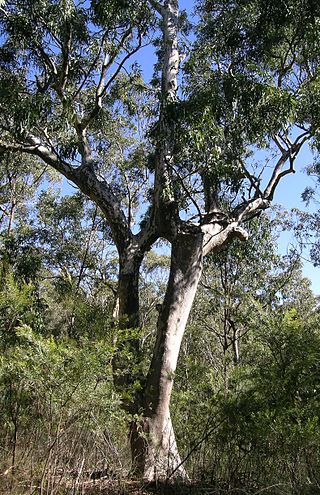
Eucalyptus michaeliana, commonly known as Hillgrove gum or brittle gum, is a species of small to medium-sized tree that is endemic to eastern Australia. It has smooth mottled greyish bark, lance-shaped to curved adult leaves, flower buds in compound umbels, white flowers and cup-shaped or barrel-shaped fruit.

Eucalyptus smithii, commonly known as the gully gum, gully peppermint, blackbutt peppermint, or ironbark peppermint, is a species of medium-sized to tall tree, sometimes a mallee, that is endemic to southeastern Australia. It has rough, compact bark on the trunk, smooth ribbony bark above, narrow lance-shaped adult leaves, flower buds in groups of seven, white flowers and cup-shaped, bell-shaped or hemispherical fruit.
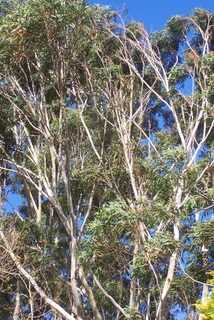
Eucalyptus pilularis, commonly known as blackbutt, is a species of medium-sized to tall tree that is endemic to eastern Australia. It has rough, finely fibrous greyish bark on the lower half of the trunk, smooth white, grey or cream-coloured bark above, lance-shaped to curved adult leaves, flower buds in groups of between seven and fifteen, white flowers and hemispherical or shortened spherical fruit.

Eucalyptus oreades, commonly known as the Blue Mountains ash, white ash or smooth-barked mountain ash, is a species of medium-sized to tall tree that is native to eastern Australia. It has smooth, powdery whitish bark with rough bark near the base, lance-shaped to curved adult leaves, flower buds in groups of seven, white flowers and cup-shaped to cylindrical fruit.

Eucalyptus deanei, commonly known as mountain blue gum, round-leaved gum, or Deane's gum, is a species of large tree endemic to New South Wales. It has smooth bark, lance-shaped leaves that are paler on the lower surface, flower buds in groups of seven to eleven, white flowers and cup-shaped to bell-shaped fruit.

Eucalyptus albens, known as the white box, is a common tree of the western slopes and plains of New South Wales and adjacent areas in Queensland and Victoria. It has rough, fibrous bark on the base of its trunk and smooth, white bark above. The leaves are lance-shaped and groups of seven spindle-shaped flower buds are arranged in leaf axils or on the ends of the branches. White flowers are mostly present between August and February and the fruit are barrel-shaped to urn-shaped.
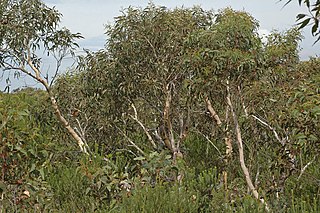
Eucalyptus racemosa, commonly known as snappy gum or narrow-leaved scribbly gum, is a species of small to medium-sized tree that is endemic to eastern Australia. It has smooth, mottled bark, lance-shaped to curved or egg-shaped adult leaves, flower buds in groups of between seven and fifteen, white flowers and cup-shaped, conical or hemispherical fruit.
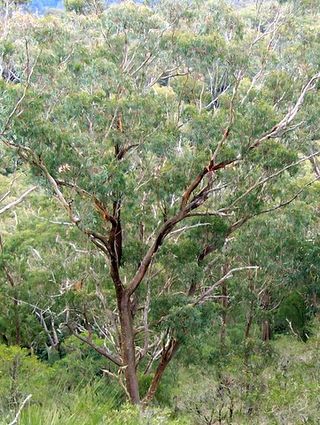
Eucalyptus campanulata, commonly known as the New England blackbutt, gum-topped peppermint or New England ash, is a tree that is endemic to eastern Australia. It has rough, finely fibrous greyish bark on the trunk and larger branches, lance-shaped to curved adult leaves, flower buds arranged in groups of between eleven and fifteen, white flowers and cup-shaped to conical fruit.

Eucalyptus major, commonly known as grey gum, is a species of tree that is endemic to a small area near the New South Wales - Queensland border. It has smooth greyish bark, lance-shaped adult leaves, flower buds in groups of seven and conical to cup-shaped fruit.

Corymbia erythrophloia, commonly known as red bloodwood, variable-barked bloodwood, red-barked bloodwood or gum-topped bloodwood, is a species of tree that is endemic to Queensland. It has rough bark on the trunk and branches, egg-shaped or lance-shaped adult leaves, flower buds in groups of seven, creamy white flowers and urn-shaped to spherical fruit.

Eucalyptus argophloia, commonly known as Queensland western white gum, Queensland white gum, scrub gum, lapunyah, Burncluith gum or Chinchilla white gum is a tree that is endemic to a small area of Queensland. It has smooth white bark ageing to other colours, narrow lance-shaped adult leaves, more or less spherical flower buds in groups of seven, white flowers and small, hemispherical to cup-shaped fruit.
Eucalyptus chartaboma, commonly known as paperbark gum, is a eucalypt that is endemic to Queensland. It is a medium-sized tree with soft, papery, fibrous bark on the lower trunk, smooth white to pale cream-coloured bark above, lance-shaped adult leaves, flower buds in groups of seven, orange-coloured flowers and oval to urn-shaped fruit. The flower buds and fruit have distinct ribs along their sides.
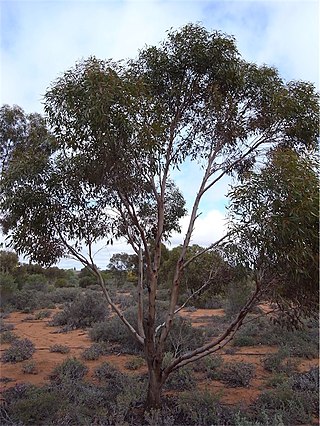
Eucalyptus dundasii, commonly known as the Dundas blackbutt, is a species of tree that is endemic to Western Australia. It has rough, scaly bark on the lower part of the trunk, smooth bark above, narrow lance-shaped to curved adult leaves, flower buds in groups of seven, creamy white flowers and cylindrical to narrow urn-shaped flowers.

Eucalyptus hallii, commonly known as Goodwood gum, is a species of small to medium-sized tree that is endemic to Queensland. It has smooth bark, lance-shaped to curved adult leaves, flower buds in groups of seven, white flower and conical fruit.
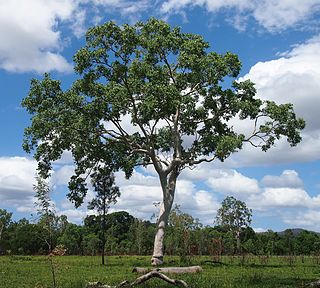
Eucalyptus platyphylla, commonly known as poplar gum or white gum, is a species of medium-sized tree that is endemic to Queensland. It has smooth. powdery bark, heart-shaped, egg-shaped to almost round leaves, flower buds in groups of seven, white flowers and conical to hemispherical fruit.




















